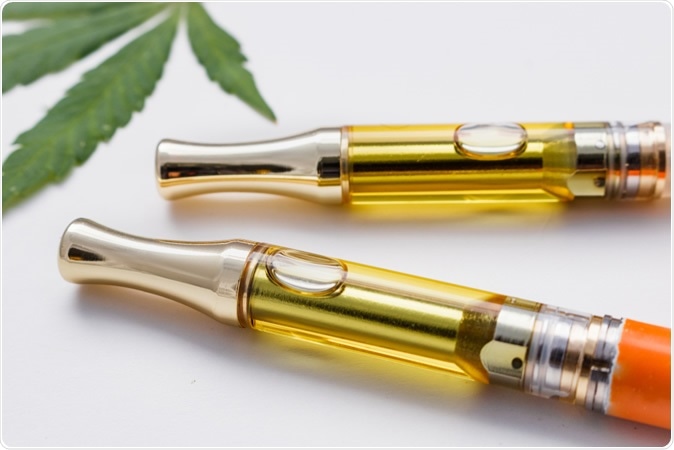A new study published in January 2020 in the journal Toxics reports that a complete analysis of the products used by patients who fell ill after using vaping products shows one component standing out – vitamin E acetate (VEA). This was the outstanding component found in e-cigarette liquids containing cannabis compounds, but not in the nicotine-containing vaping liquids.

Image Credit: Shannon Laura / Shutterstock
Searching for EVALI culprits
EVALI stands for “e-cigarette or vaping product use-associated lung injury”, which is in turn the way the recent spate of lung injuries and deaths related to vaping is referred to. In order to understand the possible cause of the lung injury, the researchers in the current study analyzed 38 samples of vaping liquid that were supposedly used by the first 10 patients diagnosed to have EVALI in New York State. The analysis was performed both in a targeted and an untargeted way, that is, they looked specifically for certain substances and also did a broader analysis to identify other compounds not listed in the suspect list. The aim was to find any compounds that could possibly account for the lung disease.
Of the 38 liquids, two samples contained nicotine while others contained cannabinoids, which are alkaloids contained in cannabis extract. The cannabinoid liquids were obtained from illicit sources and had low levels of cannabinoids as compared with more standard types of vaping liquids containing cannabis oil. Some of the samples showed atypical ratios of Δ9-/Δ8-tetrahydrocannabinol (THC). THC is the compound that is chiefly responsible for the psychotropic or mind-altering effects of cannabis or marijuana.
Pesticide in my vaping liquid sample
Again, certain of the samples tested positive for pesticides like myclobutanil and bifenthrin, a fungicide and a pyrethroid chemical used to control fungi, and to drive out fire ants, ticks, and mites, respectively. These are presumably used to enhance the harvest by preventing powder, though myclobutanil is banned. Both are known to be very hazardous on inhalation.
Vitamin E acetate
The star of the analysis was, however, VEA, which was found to be among the chief diluents in almost 65% of samples. The concentration of this oily chemical hovered between 16% and 57% by mass, depending on the sample. It is typically used to dilute or to thicken THC-containing vaping fluids.
VEA is a synthetic form of vitamin E, also called tocoferyl acetate. It is safe to ingest and to products that are applied on the skin. However, the chemical is toxic when inhaled, and is not cleared easily because of its honey-like consistency.
This laboratory was the first to identify VEA in vaping liquids obtained from patients who had EVALI. This finding was at once communicated to the U.S. Centers for Disease Control and Prevention (CDC), the U.S. Food and Drug Administration (FDA) and officials regulating public health. The researchers used email and a conference call facility.
This sparked an announcement by the New York State Department of Health on September 5, 2019, that it was investigating the role of VEA in EVALI. For this purpose, the Department bought 6 of the products which were sold as cannabis oil diluents or thickeners, online. Of these, shockingly, 3 were almost completely VEA.
The EVALI epidemic caused a major wave of ill-health, with almost 2000 people in hospitals and just short of 60 deaths from this condition. The chemical or other reason responsible for the epidemic is still being searched for. However, the investigators have confirmed that there is a strong link between EVALI and the vaping of liquid containing THC.
Still more, VEA has been identified in product samples, tested by local laboratories, as well as by the FDA. It was found not only in the vaping product but in the fluids used to wash out the lung (bronchoalveolar lavage fluid), which were tested by the CDC.
The investigation continues to seek possible causes and contributors, especially in view of the fact that no compound that could cause lung injury has been found in any of the vaping liquids containing nicotine, and that no causative link has been proved to exist between VEA and EVALI.
Journal reference:
Spink et al. Analysis of Cannabinoid-Containing Fluids in Illicit Vaping Cartridges Recovered from Pulmonary Injury Patients: Identification of Vitamin E Acetate as a Major Diluent, http://www.mdpi.com/journal/toxics